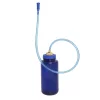Like state above "this is like shoes." Each to their own. One likes. One dislikes.
I only use a bladder now. Camelback mil spec 3L bladder.
Filling: you do not have to take the bladder out of your pack to fill. Or fill when it is in the pack and get water all over everything. You can buy a "UTA" device (means Universal Tube Adaptor). You unsnap your mouth piece and snap the UTA on the hose. Put purchased water bottle i.e, 1 L bottle, hold up the hose higher than your bag and fill. You can also fill from a faucet.
The UTA fitting fits the larger size (newer) camelbak hose. If not, you can buy an adaptor kit to convert yours to the newer size.
https://www.amazon.com/dp/B008S9EH04/?tag=casaivar02-20
3L vs 2L vs 1L bags: I always take my 3L bag. Not much weight (empty) between 3L vs a 2 L bag. BUT, is nice to have the extra water when need it on long hauls. Even on the Ingles there was one or two stretches that I was glad I had 3 L in the bag instead of 1 or 2 L or small plastic disposal bottles.
Inside or outside bag bladder?? Camelbak recently came out with a bladder case/holder that holds your bladder on the EXTERIOR of your pack. I will try and find a link for this holder. I used it on the Ingles and got many good comments about it. I have not seen this new exterior pack bladder case on the market yet. I got mine from a store that was test selling for camelbak. and glad I got it. It is not the type with shoulder straps on it or a chest strap. Only secures to the back (exterior) of your back. Wonderful.
The holder is insulated some. Durable. Fit on my Osprey pack perfect. Was on the outside of the back of my pack.
I put it inside the pack (actually the outter pouch on the pack) when put pack on the bus and train.
I was impressed by the UTA and the exterior bladder case. Great job Camelbak.
Mil spec vs regular Camelbak bags/bladders. Mil spec bladders are stronger. Weight about the same. More durable. Have baffle inside the bladder. Stop the splashing noise and shifting of water when on your back.
Mil spec Antidote is the best bladder/hose system on the market. Next I would say Osprey has a great bag and hose.
Mil spec by Camelbak has 1/4 turn no spill cap. Has hydrolock on hose and bag to shut off water flow when not drinking. Uses the Quick Link system.
http://shop.camelbak.com/mil-spec-antidote-reservoirs/l/711
Nothing wrong with regular non mil spec bladder, hose and mouth piece. But the mil spec ones are stronger. Better made and will hold up much longer.
At the end of the day, I dumped any remaining water out. Refilled with fresh. After about 3 days or so I used one Camelbak cleaning tab in 1L of water in the bag. Let sit 5 min. Ran water out hose, mouth piece to clean them too. Rinsed with fresh. Refilled with fresh and went on my way. Never had a problem with nasty water. Mold etc. Mil spec is antibaterical so no mold issues. There is a term for this but forgot it.
I will never go back to water bottles. having to take pack off to find the bottle(s). Don't know about other packs...but try and grab a water bottle out of the side pockets on a Osprey pack. Yes there are two ways to put bottles in the Osprey outside holder. And I dont like either way.





















